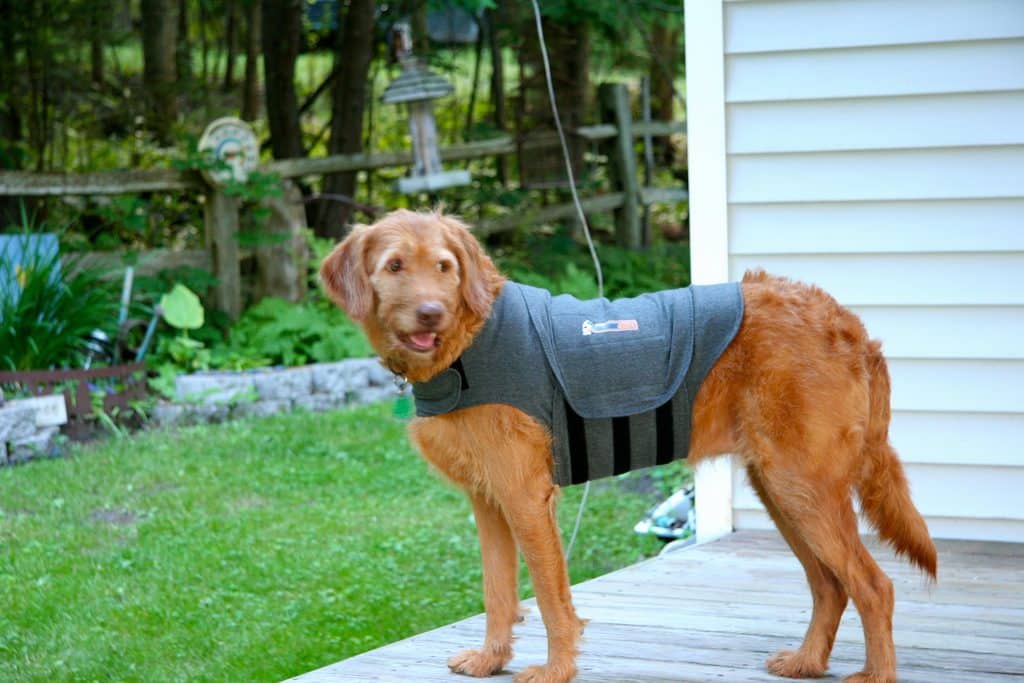What Are Dogs Scared of the Most
- This post contains affiliate links. Read more here.
You come home to find the furniture chewed up . Maybe there's poop in your shoes. Your dog jumps at the end of the leash anytime another dog walks by—or simply won't get in the car. You don't need a degree in dog psychology to know something is wrong. Common dog fears often lead to these behaviors. So what do you do?
Want to understand dog psychology? Familiarize yourself with these common dog fears, then learn how to alleviate them.
Like humans, our beloved dogs are prone to a variety of fears. Some of these are innate, while others are the result of scary experiences. Recognizing common dog fears and knowing basic tips to address them will help your canine companion and deepen your relationship.


Flickr/gullevek
You probably inundated your dogs with attention, affection, and a long weekend when you first brought them home. But eventually, work or travel takes you away for extended periods.
Separation anxiety in dogs is real. A dog suffering from this anxiety may destroy property, bark excessively, or even chew on their own tail or engage in other compulsive behaviors.
Training tips:
Dogs that fear the car might be responding to a fear of being trapped, or may simply feel unwell once those wheels start turning. Car sickness is a real problem for some dogs, and symptoms can include drooling, whining, and vomiting—so it's no wonder it might lead dogs to fear the car.
Even if your dog doesn't suffer from full-on motion sickness, he may have had previous bad experiences with the car that lead him to be reluctant about jumping in.
Training tips:
- If the car is a scary place, just approaching it will produce anxiety. Help your dog form a positive reaction to the car before even starting the engine. Walk up to and around the car, giving your dog lots of treats as you do.
- Slowly introduce your dog to the inside of the car this way, too, before you actually go anywhere.
- If your dog's motion sickness is bad and regularly induces vomiting, limit food before car trips. You may also want to consider providing your dog with anti-nausea medication before you travel. Talk to your vet for options.
- Make car trips as comfortable as possible with a safe seatbelt, comfy blanket, and soothing music (which can help some dogs.)

Another common culprit among fearful dogs is noise anxiety, whether it's caused by fireworks or thunderstorms or the vacuum cleaner.
Sudden or perpetual loud noises can initiate something akin to a dog panic attack, and knowing how to react—or not to react—is important.
Training tips:
- Don't overcompensate, pretending nothing is happening or refusing all cuddling, but focus on something fun that your dog would do when they're not anxious.
- Some recommend dog playtime during a storm, reinforced by "thunder treats" and other tricks to associate the noise with a positive experience. These are all aspects of CCC (classic counter-conditioning).
- Many dog owners also swear by the ThunderShirt
, a research-based solution that uses pressure to soothe.
4. What are these creatures? Fear of strange dogs and people
Dog fears often revolve around the unknown, whether it's a fear of strangers or afear of other dogs. In both cases, socialization is key, and will take patience and time.
Training tips:
- The leash is going to be helpful in this process, whether you're out for a walk or even in the house.
- Don't force interaction with humans. Let your dog get comfortable at a distance, rather than forcing them closer.
- With other dogs, keep treats as a reward for calm behavior while another pooch passes.
- For some dogs, especially those with a difficult past,reactivityis a larger issue that will require positive training techniques and practical solutions such as avoiding triggers. Read more about reactive dogs here and here.
Was it something I said? My breath? If your adopted dog is afraid of you from day one, this is due to past negative experiences. With patience, you can gain your dog's confidence and trust.
In general, your body language and stress level affect your dog, so much so that you might be accidentally scaring your dog if you've had a bad day. A quick strategy? Take a breath, project calm confidence, and your dog might just relax, too.
Training tips:
- Spend time on the floor—as much on your dog's level as possible—so they don't feel dominated.
- Slow movements, gentle gestures, and lots of treats can be helpful.
- This may also be a time to consult a professional canine behaviorist or dog trainer specializing in anxious or reactive dogs. Take video and describe behaviors first.
Top image via Flickr/Tim Dawson, Creative Commons license
- This post contains affiliate links. Read more here.
You come home to find the furniture chewed up . Maybe there's poop in your shoes. Your dog jumps at the end of the leash anytime another dog walks by—or simply won't get in the car. You don't need a degree in dog psychology to know something is wrong. Common dog fears often lead to these behaviours. So what do you do?
Want to understand dog psychology? Familiarize yourself with these common dog fears, then learn how to alleviate them.
Like humans, our beloved dogs are prone to a variety of fears. Some of these are innate, while others are the result of scary experiences. Recognizing common dog fears and knowing basic tips to address them will help your canine companion and deepen your relationship.


Flickr/gullevek
You probably inundated your dogs with attention, affection, and a long weekend when you first brought them home. But eventually, work or travel takes you away for extended periods.
Separation anxiety in dogs is real. A dog suffering from this anxiety may destroy property, bark excessively, even chew on their own tail, or engage in other compulsive behaviours.
Training tips:
Dogs that fear the car might be responding to a fear of being trapped, or may simply feel unwell once those wheels start turning. Car sickness is a real problem for some dogs, and symptoms can include drooling, whining, and vomiting—so it's no wonder it might lead dogs to fear the car.
Even if your dog doesn't suffer from full-on motion sickness, he may have had previous bad experiences with the car that lead him to be reluctant about jumping in.
Training tips:
- If the car is a scary place, just approaching it will produce anxiety. Help your dog form a positive reaction to the car before even starting the engine. Walk up to and around the car, giving your dog lots of treats as you do.
- Slowly introduce your dog to the inside of the car this way, too, before you actually go anywhere.
- If your dog's motion sickness is bad and regularly induces vomiting, limit food before car trips. You may also want to consider providing your dog with anti-nausea medication before you travel. Talk to your vet for options.
- Make car trips as comfortable as possible with a safe seatbelt, comfy blanket, and soothing music (which can help some dogs.)

Another common culprit among fearful dogs is noise anxiety, whether it's caused by fireworks or thunderstorms or the vacuum cleaner.
Sudden or perpetual loud noises can initiate something akin to a dog panic attack, and knowing how to react—or not to react—is important.
Training tips:
- Don't overcompensate, pretending nothing is happening or refusing all cuddling, but focus on something fun that your dog would do when they're not anxious.
- Some recommend dog playtime during a storm, reinforced by "thunder treats" and other tricks to associate the noise with a positive experience. These are all aspects of CCC (classic counter-conditioning).
- Many dog owners also swear by the ThunderShirt
, a research-based solution that uses pressure to soothe.
4. What are these creatures? Fear of strange dogs and people
Dog fears often revolve around the unknown, whether it's a fear of strangers or afear of other dogs. In both cases, socialization is key, and will take patience and time.
Training tips:
- The leash is going to be helpful in this process, whether you're out for a walk or even in the house.
- Don't force interaction with humans. Let your dog get comfortable at a distance, rather than forcing them closer.
- With other dogs, keep treats as a reward for calm behaviour while another pooch passes.
- For some dogs, especially those with a difficult past,reactivityis a larger issue that will require positive training techniques and practical solutions such as avoiding triggers. Read more about reactive dogs here and here.
Was it something I said? My breath? If your adopted dog is afraid of you from day one, this is due to past negative experiences. With patience, you can gain your dog's confidence and trust.
In general, your body language and stress level affect your dog, so much so that you might be accidentally scaring your dog if you've had a bad day. A quick strategy? Take a breath, project calm confidence, and your dog might just relax, too.
Training tips:
- Spend time on the floor—as much on your dog's level as possible—so they don't feel dominated.
- Slow movements, gentle gestures, and lots of treats can be helpful.
- This may also be a time to consult a professional canine behaviourist or dog trainer specializing in anxious or reactive dogs. Take video and describe behaviours first.
Top image via Flickr/Tim Dawson, Creative Commons license
What Are Dogs Scared of the Most
Source: https://www.rover.com/blog/common-dog-fears/
0 Response to "What Are Dogs Scared of the Most"
Post a Comment